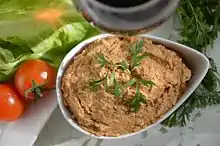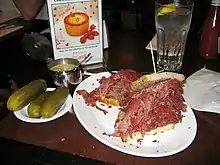American Jewish cuisine comprises the food, cooking, and dining customs associated with American Jews.[1] It was heavily influenced by the cuisine of Jewish immigrants who came to the United States from Eastern Europe around the turn of the 20th century.[2][3] It was further developed in unique ways by the immigrants and their descendants, especially in New York City and other large metropolitan areas of the northeastern U.S.[4][5]
History
Between 1881 and 1921, around 2.5 million Jews immigrated to the United States from Eastern Europe.[3] Most of them settled in large cities in the northeastern part of the country, especially New York, Philadelphia, Boston, Cleveland, Chicago, and Baltimore.[6] These immigrants brought with them a well-developed culinary heritage. The cuisine continued to evolve in America, in the homes of the immigrants and their descendants, and in delicatessens and appetizing stores in New York City and elsewhere.[1]
Delicatessens were quite popular among second-generation American Jews, especially in the mid-twentieth century. They provided a place for the patrons to socialize in a comfortable environment. They also popularized some of the dishes now associated with American Jewish cuisine, which were affordable for their upwardly mobile customers, but which would have seemed luxurious to their European ancestors.[7][8][9] Though not as numerous as they once were, delicatessens continue to be popular dining destinations.[10][11][12]
Kosher food
Kosher food is food that conforms to kashrut, i.e. Jewish dietary laws. Under these rules, some foods – for example, pork and shellfish – are forbidden. Any meat must come from an animal that was slaughtered using a process known as shechita. Jewish dietary law also prohibits the eating of meat and milk at the same meal. For this purpose, "meat" means the flesh of mammals and birds, and "milk" includes dairy products such as cheese and butter. Thus a kosher delicatessen selling corned beef sandwiches would not have any cheese, and a kosher bakery selling bagels and cream cheese would not have any meat. Many foods are classified as pareve (sometimes spelled "parve") – neither meat nor milk, and therefore acceptable at any meal. Pareve foods include fish, eggs, honey, and any edible plant.[13][14] Kosher commercial establishments must be closed from Friday evening to Saturday evening, during the Jewish sabbath.
American Jewish cuisine may or may not be kosher. For example, some delicatessens follow Jewish dietary law in the preparation and serving of food, while others do not. Followers of Orthodox Judaism, the most traditional form of Judaism, generally eat only kosher food. Some other more-observant Jews also eat kosher food most or all of the time. However, the majority of American Jews are less observant of traditional rules, and eat non-kosher food. According to a 2012 study by the Pew Research Center, 22 percent of American Jews keep kosher in their homes.[15]
Kosher-style food
Kosher-style food is food that is made in the style of kosher food but that does not necessarily conform to Jewish dietary laws. For example, a kosher-style hot dog is an all-beef hot dog that is mildly spiced with garlic and other flavorings, and a kosher-style pickle is a sour pickle aged in brine with garlic and dill. The term "kosher-style" may also refer to American Jewish cuisine in general.[16] The Reuben sandwich, a kosher-style staple, is not kosher because it combines Swiss cheese and corned beef.[17]
Passover
During the annual eight-day Passover holiday, Jews who are more traditionally observant do not eat chametz (leavened bread). During Passover some American Jews eat matzah and other foods that conform to this restriction.[18][19]
American Jews, like Jews elsewhere in the world, often participate in a Passover seder at the beginning of Passover. This is a ritual meal that includes the telling of the story of Passover – the Exodus of the Jews from Egypt. At a seder, the Passover Seder plate is a plate with special food items that are symbolic of different aspects of Passover.[20]
Ashkenazi, Sephardic, and Mizrahi cuisine
Around 90% of American Jews are Ashkenazi Jews, whose ancestors came from Eastern or Central Europe, where many of them spoke Yiddish as their first language. The foods commonly associated with American Jewish cuisine therefore have their origins in those regions.
The United States also has a sizeable population of Sephardic Jews, whose ancestors lived in Spain or Portugal, and later in other Mediterranean areas, and Mizrahi Jews, whose ancestors lived in the Middle East or North Africa.[6][21] Sephardic and Mizrahi Jews have their own distinct cuisines, which, like Ashkenazi cuisine, were heavily influenced by their places of origin.[22][23] Although always outnumbered by their Ashkenazi counterparts, there are significant Sephardic and Mizrahi communities across America. These include the Persian Jews of Los Angeles,[24][25] the Moroccan Jews of Manhattan,[26] the Turkish Jews of Seattle,[27] and the Syrian Jews of Brooklyn.[28] Additionally, Mizrahi and Sephardic cuisine predominates in the modern state of Israel.
Therefore, Middle Eastern and Mediterranean dishes such as falafel, hummus, couscous, and shakshouka are also part of American Jewish cuisine.[29][30]
Litvaks and Galitzianers
The two largest groups of Eastern European (Ashkenazi) Jews were Litvaks, who lived farther to the north and east, in the area of Lithuania, and Galitzianers, who lived farther to the south and west, in the area of Galicia. Each group spoke their own dialect of Yiddish. According to some writers, it is sometimes possible to guess the ancestry of an American Jew by knowing their preferred style of gefilte fish.[31] Litvaks ate gefilte fish that was flavored with salt and pepper, while Galitzianers preferred theirs to be sweeter.[32] The border between the areas where Litvaks and Galitzianers lived has therefore been referred to as the "Gefilte Fish Line".[32][31]
Popular dishes and foods



Popular dishes in American Jewish cuisine include:
- Bagel – A doughnut-shaped bread roll. The dough is first boiled and then baked, resulting in a dense, chewy interior with a browned exterior.[33][34]
- A bagel and cream cheese is a popular pairing.[35]
- Bialy – A bread roll similar to a bagel, but without a hole, and somewhat less chewy as the dough is not boiled before being baked.[36]
- Blintz – A fried crêpe, usually filled with farmer cheese and served with various toppings.[37]
- Brisket – An inexpensive cut of beef that is braised as a pot roast.[38]
- Challah – A light bread made with eggs, used as regular food, and on ritual or holiday occasions.[39]
- Chicken soup – Chicken broth with herbs like parsley, dill, or thyme, and often with egg noodles added.[40]
- Matzah balls are sometimes added to the soup instead of, or in addition to, noodles.[40][41]
- Kreplach are small dumplings that are another common addition to chicken soup.[41]
- Chopped liver – A liver pâté made with hard-boiled eggs, salt, and pepper. Served as a side dish, hence the expression, "What am I, chopped liver?"[42]
- Corned beef – Beef brisket that has been cured with brine and spices and then sliced.[40][43]
- Corned beef sandwich – A common use of corned beef.
- Gefilte fish – Ground fish – often a combination of carp, pike, and whitefish – that is mixed with other ingredients, formed into patties or balls, and poached; usually served as an appetizer.[44][31][32]
- Kishke – A large, starchy sausage made with grain, vegetables, beef or chicken fat, and spices.[45]
- Knish – A type of savory baked turnover; various fillings are used, such as potatoes or ground beef.[40][46]
- Kugel – A baked casserole made with egg noodles or potatoes.[47][48]
- Latke – A pancake made with grated potatoes and other ingredients, fried in oil.[49]
- Lox – A sliced fillet of cured salmon. Belly lox is cured with brine and is therefore rather salty. Nova lox is cold-smoked. Lox is often eaten as a sandwich, on a bagel with cream cheese.[50]
- Mandelbrot – A crunchy cookie, sometimes made with almonds, formed by baking a loaf which is then cut into small slabs and twice-baked.[51]
- Pastrami – Beef brisket that has been cured with brine, rubbed with pepper, garlic, and other spices, smoked, and then sliced.[40] Like corned beef it is usually served as a sandwich.[43]
- Pastrami on rye – Pastrami on rye bread topped with spicy brown mustard.[52][53]
- Rugelach – Small baked pastries made by wrapping dough around a filling.[54]
- Whitefish – Smoked freshwater whitefish, either filleted or made into whitefish salad.[55][56]
- American Jewish foods

 A latke
A latke A pastrami on rye with kosher dill pickles and spicy brown mustard
A pastrami on rye with kosher dill pickles and spicy brown mustard Blackberry rugelach
Blackberry rugelach
Commercial establishments
Notable American Jewish restaurants, delicatessens, grocery stores, and food and wine companies include:
- Acme Smoked Fish Corp.
- Barney Greengrass
- Brent's Deli
- Canter's
- Carnegie Deli
- Creole Kosher Kitchen
- D.Z. Akin's
- Empire Kosher
- Gertle's Bake Shop
- Hebrew National
- IDT Megabite Cafe
- Jerry's Famous Deli
- Katz's Delicatessen
- Kedem Winery
- Kenny & Zuke's Delicatessen
- Langer's Deli
- Lindy's
- Loeb's NY Deli
- Manischewitz
- Mile End Delicatessen
- Murray's Sturgeon Shop
- Ratner's
- Reuben's Restaurant
- Russ & Daughters
- Second Avenue Deli
- Streit's
- Wolfie Cohen's Rascal House
- Yonah Shimmel's Knish Bakery
- Zabar's
Dining at Chinese restaurants on Christmas
The American Jewish custom of eating at Chinese restaurants on Christmas Day or Christmas Eve is a common stereotype portrayed in film and television, but it has a factual basis. The tradition may have arisen from the lack of other open restaurants on Christmas, as well as the close proximity to each other of Jewish and Chinese immigrants in New York City.[57][58][59][60] Another reason is the near-total absence of dairy products in Chinese food, making it easy to order a meat dish that doesn't contain dairy.
See also
References
- 1 2 Paster, E. (2017). The Joys of Jewish Preserving: Modern Recipes with Traditional Roots, for Jams, Pickles, Fruit Butters, and More—for Holidays and Every Day. Harvard Common Press. p. 12. ISBN 978-1-55832-903-4. Retrieved August 9, 2017.
- ↑ Wallach, J.J. (2013). How America Eats: A Social History of U.S. Food and Culture. American ways series. Rowman & Littlefield. pp. 82–88. ISBN 978-1-4422-0874-2. Retrieved August 9, 2017.
- 1 2 Smith, A.F. (2004). The Oxford Encyclopedia of Food and Drink in America: A-J. The Oxford Encyclopedia of Food and Drink in America. Oxford University Press. p. 739. ISBN 978-0-19-517551-6. Retrieved August 10, 2017.
- ↑ Koenig, Leah. "American Jewish Cuisine". My Jewish Learning. Retrieved August 6, 2017.
- ↑ Nathan, Joan (March 1, 2009). "Food in the United States". Jewish Women's Archive. Retrieved August 6, 2017.
- 1 2 Zollman, Joellyn. "Jewish Immigration to America: Three Waves". My Jewish Learning. Retrieved August 6, 2017.
- ↑ Sokan, Kenny (March 31, 2016). "Pastrami on Rye: A Full-Length History of the Jewish Deli". PRI. Retrieved August 6, 2017.
- ↑ Merwin, Ted (October 4, 2015). "Tasty Bits from the History of the Jewish Deli". New York Post. Retrieved August 6, 2017.
- ↑ Magarik, Raphael (January 25, 2016). "How Pastrami Helped to Create American Jewish Culture". Forward. Retrieved August 7, 2017.
- ↑ Nathan, Joan (October 6, 2009). "At Jewish Delis, Times Are as Lean as Good Corned Beef". The New York Times. Retrieved August 7, 2017.
- ↑ Bruner, Raisa (April 20, 2016). "The 26 Best Jewish Delis in America, According to Foursquare". Business Insider. Retrieved August 6, 2017.
- ↑ Chu, Louisa (November 6, 2017). "What Happened to the Big Jewish Delis in Chicago?". Chicago Tribune. Retrieved November 6, 2017.
- ↑ "Kosher Food: What Makes Food Kosher or Not". My Jewish Learning. Retrieved August 6, 2017.
- ↑ "Kashrut: Jewish Dietary Laws". Judaism 101. Retrieved August 6, 2017.
- ↑ Shimoni, Giora (July 10, 2017). "Do All Jews Keep Kosher?". The Spruce. Retrieved August 6, 2017.
- ↑ Levin, Sala (July 26, 2013). "From Pickles to Salmon, the Joys of Kosher-Style". Moment Magazine. Retrieved August 6, 2017.
- ↑ Genger, Tamar (October 30, 2014). "Making a Kosher Reuben Sandwich". Jamie Geller. Retrieved April 6, 2023.
- ↑ "What It Means to Keep Kosher for Passover". My Jewish Learning. Retrieved August 6, 2017.
- ↑ Lewis, Danny (April 21, 2016). "For the First Time in 800 Years, Rice and Beans Are Kosher for Passover". Smithsonian Magazine. Retrieved August 6, 2017.
- ↑ Pelaia, Ariela (March 1, 2016). "What Are the Symbols of the Seder Plate?". ThoughtCo. Retrieved August 6, 2017.
- ↑ "What do Ashkenazi, Sephardic, and Mizrahi mean?". Coffee Shop Rabbi. May 3, 2016. Retrieved August 6, 2017.
- ↑ Avey, Tori (7 January 2010). "Ashkenazi vs. Sephardic Cuisine". Tori Avey. Retrieved August 6, 2017.
- ↑ Guttman, Vered (September 11, 2012). "Ladino in the Air, Sephardi Foods on the Table". The Washington Post. Retrieved August 6, 2017.
- ↑ Nahai, Gina (November 4, 2014). "How Iranian Jews Shaped Modern Los Angeles". Forward. Retrieved October 22, 2017.
- ↑ "The Persian Conquest".
- ↑ Lipman, Steve (June 25, 2014). "Sephardic Wave Rolling into Manhattan". The New York Jewish Week. Retrieved October 22, 2017.
- ↑ "An Over 100-Year-Old History of Turkish Sephardic Jews in Seattle". Turk of America. October 6, 2009. Retrieved October 22, 2017.
- ↑ Chafets, Zev (October 14, 2007). "The Sy Empire". The New York Times. Retrieved October 22, 2017.
- ↑ Sietsema, Robert (October 25, 2016). "Where to Find Sephardic Jewish Food in NYC and Its Suburbs". Eater. Retrieved October 22, 2017.
- ↑ Miller, Aly (August 22, 2016). "Where to Find the Best Shakshuka in NYC". My Jewish Learning. Retrieved October 22, 2017.
- 1 2 3 "This Is No Fish Tale: Gefilte Tastes Tell Story of Ancestry". The Jewish News of Northern California. September 10, 1999. Retrieved August 7, 2017.
- 1 2 3 Prichep, Deena (September 24, 2014). "The Gefilte Fish Line: A Sweet and Salty History of Jewish Identity". NPR. Retrieved August 9, 2017.
- ↑ Nathan, Joan (November 12, 2008). "A Short History of the Bagel". Slate. Retrieved August 6, 2017.
- ↑ Weinzweig, Ari (March 26, 2009). "The Secret History of Bagels". The Atlantic. Retrieved August 6, 2017.
- ↑ Falkowitz, Max (July 2014). "Bagelnomics: The Curious Pricing of New York's Bagel With Cream Cheese". Serious Eats. Retrieved August 6, 2017.
- ↑ Orchant, Rebecca (February 14, 2014). "Why the Bialy Is Better than Any Bagel You've Ever Had". Huffington Post. Retrieved August 6, 2017.
- ↑ Avey, Tori (24 January 2013). "Ratner's Cheese Blintzes: Meyer Lansky's Favorite Dish". Tori Avey. Retrieved August 7, 2017.
- ↑ Yeh, Molly (December 20, 2012). "Brisket: The Holy Grail of Jewish Food". Forward. Retrieved August 7, 2017.
- ↑ Roden, Claudia. "What Is Challah?". My Jewish Learning. Retrieved August 7, 2017.
- 1 2 3 4 5 Kraig, B.; Carroll, P. (2012). Man Bites Dog: Hot Dog Culture in America. AltaMira studies in food and gastronomy. AltaMira Press. p. 150. ISBN 978-0-7591-2073-0. Retrieved August 10, 2017.
- 1 2 "Ask the Expert: Matzah Balls vs. Kreplach". My Jewish Learning. Retrieved August 6, 2017.
- ↑ "What Am I, Chopped Liver?". Ohr Somayach. Retrieved August 6, 2017.
- 1 2 Rosengarten, David (March 13, 2014). "It's Corned Beef Time, But Don't Forget the Pastrami!". Huffington Post. Retrieved August 7, 2017.
- ↑ Spiegel, Alison (April 1, 2015). "What Exactly Is Gefilte Fish, and Is It Good or Gross?". Huffington Post. Retrieved August 7, 2017.
- ↑ Miller, Aly (October 14, 2016). "What Is a Kishke?". My Jewish Learning. Retrieved August 7, 2017.
- ↑ Wasserman, Tina (Winter 2009). "The Ultimate Jewish Finger Food". Reform Judaism Magazine. Archived from the original on December 22, 2010. Retrieved August 6, 2017.
- ↑ Nathan, Joan (September 28, 2005). "Kugel Unraveled". The New York Times. Retrieved August 7, 2017.
- ↑ Robinson, Avery (December 31, 2014). "One Man's Moby-Dick Is Another Man's Kugel". Tablet Magazine. Retrieved August 7, 2017.
- ↑ Appelbaum, Yoni (December 11, 2015). "Everything You Know About Latkes Is Wrong". The Atlantic. Retrieved August 7, 2017.
- ↑ Dixler, Hillary (June 30, 2014). "The Classic Bagel and Salmon Sandwich at Russ & Daughters in New York City". Eater. Retrieved August 6, 2017.
- ↑ Skenazy, Lenore (July 7, 2010). "You Say Mandel Bread, I Say Biscotti". Forward. Retrieved August 7, 2017.
- ↑ Baxter, Jenny (August 9, 2017). "Favorites stand the test of time". Calaveras Enterprise. Retrieved August 10, 2017.
- ↑ "The 12 rules for not getting in trouble at Katz's Deli". Star Tribune. November 17, 2015. Retrieved August 10, 2017.
- ↑ Triantafillou, Niko (November 2013). "Where to Get Rugelach in New York City". Serious Eats. Retrieved August 6, 2017.
- ↑ Achitoff-Gray, Niki (September 2014). "Lox, Whitefish, and Beyond: An Introduction to Appetizing". Serious Eats. Retrieved August 6, 2017.
- ↑ Kapadia, Jess (April 29, 2013). "Whitefish Salad, The Bagel's Secret Lover". Food Republic. Retrieved August 6, 2017.
- ↑ Chandler, Adam (December 23, 2014). "Why American Jews Eat Chinese Food on Christmas". The Atlantic. Retrieved August 6, 2017.
- ↑ Yam, Kimberly (December 22, 2016). "The Reason Jews Eat Chinese Food on Christmas Is Rooted in Solidarity". Huffington Post. Retrieved August 6, 2017.
- ↑ Witchel, Alex (December 17, 2003). "For Some, It's a Very Moo Shu Christmas". The New York Times. Retrieved August 6, 2017.
- ↑ Tracy, Marc (December 25, 2012). "Why Eating Chinese Food on Christmas Is a Sacred Tradition for American Jews". Tablet Magazine. Retrieved August 9, 2017.

